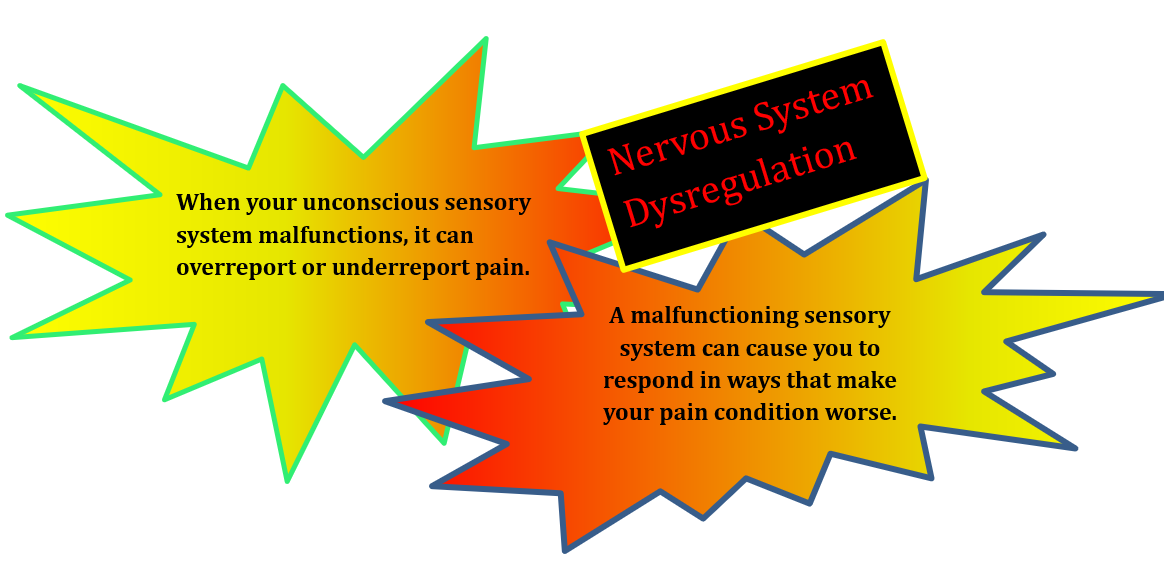New Frontiers in the Treatment of Chronic Pain – Part 1, the Updated Science
(The video provides a brief overview; read the article below for a more in-depth understanding.)
Are you suffering from chronic pain?
If you’re reading this article, you have likely suffered from chronic pain and illness, possibly for years. Your condition may range from chronic anxiety and depression to hypertension, back pain, migraines, fibromyalgia, and autoimmune disease. Maybe it’s not you; instead, it’s someone you care about, a friend, a family member, or a coworker. You have probably gone through years of struggle with endless visits to doctors, psychotherapists, alternative practitioners, medications, supplements, and special diets. And even with all these efforts, there are no lasting results, and your condition perpetuates anyway.

Chronic Pain Can Feel Dark and Isolating
It’s also likely that through your struggle, you’re left with this deep-seated feeling that it’s your fault. You probably have thoughts like, “Maybe I’m not trying hard enough,” or “Maybe I’m broken in a way that no one can fix.” Even loving friends and family can make you feel worse by saying things that are well meant but not helpful, like, “Yes, but you look good,” or “Try thinking more positively,” and finally, a typical New Age response to someone’s illness, “Maybe you should look at why you’re attracting this illness to your life.”
These are horrible things to say to someone in pain. It’s especially harmful because of the implicit assumption that if healthcare professionals can’t find anything wrong with you, it must be in your mind. People assume that because it’s in your mind, you should be able to consciously will yourself back to health by changing your thoughts. Therefore, if you’re not healthy, it’s because you don’t want to be healthy. In contrast, modern neuroscience shows us that it’s not in your mind, it’s not your fault, and you’re not broken; instead, your unconscious nervous system needs adjusting.
This article is the first in a three-part series on chronic pain.
In this three-part series on chronic pain, I’ll show you how to tune your nervous system to get lasting relief. To begin, I will illustrate how the updated neuroscience explains how chronic pain and illness manifest, what works to bring you back to health, and how the traditional scientific view of our nervous system gets in the way of healing. Here are the main points that I will cover:
1. The new science tells us that chronic disease is caused by a malfunction in the unconscious nervous system’s response to your environment resulting in chronic stress.
2. When this unconscious system becomes dysfunctional and unreliable, it can cause or prolong chronic pain and illness.
3. To adjust the unconscious response system and manage stress more effectively, it is essential to:
a. Understand the basics of the updated science.
b. With the updated science as your guide, engage in supportive lifestyle changes, therapies, and regular self-care practices that expand your tolerance to the experiences that trigger harmful stress responses.
What is the difference between the traditional and new scientific view of pain?

Let’s begin by looking at the traditional pain model. The conventional scientific view states that you feel pain because your body is damaged. Therefore, you will only feel pain when you are hurt. For example, the illustration below shows someone feeling pain when hitting their thumb with a hammer.

The Amount of Pain Felt from the Same Injury Can Vary From Person to Person
The conventional view assumes that the amount of pain you feel will equal the force with which you strike your thumb. Additionally, this theory explains that we have pain receptors in the body, which send messages from the body to the brain to signal the amount of damage in the thumb.
Therefore, the traditional understanding of pain is that the amount of pain you feel will equal the amount of damage done to your body. Damage equals pain level is the model taught to most doctors and health care practitioners.


In contrast, the new scientific view explains that we have sensation sensors in our body, not pain receptors. These receptors collect information about temperature, pressure, movement, texture, etc. This sensory data is sent to the subconscious, where it is analyzed. Then the subconscious decides how much pain to report to the brain based on its analysis; finally, the subconscious chooses how much pain to express based on past experiences, personal temperament, and genetics. This new model indicates that the level of pain you feel is based on your unconscious interpretation of the damage instead of the amount of damage done.
Therefore, the pain level you experience in any situation is somewhat arbitrary, especially if you have chronic conditions. What I mean by arbitrary is that it does not necessarily correspond to the reality of the problem. Because pain can be arbitrary, you may feel pain even if you are not injured.

You Can Feel Sick Even When You Are Not Sick
The image above is another example of pain or discomfort. We’re guessing this couple either has the flu or a cold. We would assume they aren’t well because of their body language, facial tissues, and red noses. In this case, most people would think, just like the hammer hitting the thumb, that there is an obvious reason for feeling bad. They feel bad because a virus, bacteria, or something toxic is raging in their bodies. Although it sounds logical, current neuroscience says this model is only accurate sometimes. Therefore, the degree to which you feel discomfort from a given illness is not necessarily related to the actual severity of the disease. Essentially, you can feel sick even if you aren’t sick.
I’m not sure I buy this new science; it doesn’t match my experience.
Now at this point, you might say, “Wait a minute Michael, come on, when I hit my finger with a hammer it hurts and when I have a cold or flu, it’s terrible in the same way, every time, so the traditional view of pain and illness must be correct, it matches my experience.”. I understand that sometimes this model seems accurate because sometimes it is accurate. However, even without looking at scientific studies, personal experience often contradicts the damage equals pain model.
Let’s look at some examples of common occurrences that poke holes in the traditional model and support the new model of pain:
Being Injured and not feeling pain – Think about how often you have hurt yourself, maybe even severely, and only realized it hours or days later. And even if you haven’t experienced delayed pain after an injury, you probably know someone who has, including one of your favorite sports heroes. There are many stories of athletes playing a game with a broken ankle or something similar, only to realize the severity of their injury after the game.
Soldiers don’t feel the pain from a gunshot wound – Many soldiers are badly injured in battle but don’t stop fighting because they don’t feel any pain. They only stop when the battle ends or someone notices they are hurt and insists they get medical help. Then as soon as the soldier is attended to and calms down a little, he/she is overwhelmed by pain.
Symptoms of stress mimic illness – Overwhelming stress can cause symptoms that resemble the flu or cold. It is also worth noting the number of people who only get sick during weekends and holidays, the most stressful time of the week/year for many. Additionally, stressful experiences can trigger skin rashes, hives, or sudden bouts of diarrhea. Stress-induced symptoms can potentially mimic the hallmarks of almost any common disease, including heart attacks, cancers, and strokes.

Chronic Stress Can Trigger Symptoms That Don’t Make Sense Medically
People often react differently to the same stimulus – Individuals can have distinctly different tolerances to the same stimulus, including hot or cold temperature, injury, physical exertion, sound levels, and even social situations. For example, some people experience hot weather as pleasant, while others find it distressing. For some, nightclubs are exciting, while others can’t stand the noise, smells, and crowds. At a big social event, the shy introvert will be inclined to grab a drink, hide in a corner, and calculate when he/she can leave without being rude to the host. In contrast, the extrovert is energized by social situations and often finds it difficult to leave an event because he/she is having so much fun.
As you can clearly see from the examples above, if our nervous system was designed to report the amount of damage or illness to us that was factually real, then the athlete and soldier would not be able to be unaware of their injuries at the time of the injury. Likewise, stress would not be able to mimic other pain conditions and diseases because our nervous system would only be reporting whether we are sick or not instead of expressing symptoms that medical tests can’t justify. And finally, the fact that individuals can have vastly different tolerances to the same experiences also points to problems with the traditional pain model. All these examples support the idea that the subconscious can alter the experience of pain and discomfort regardless of the medically measurable level of injury or illness.
How does a functioning sensory system protect your health?
Imagine you accidentally put your hand on a stove, your hand automatically moves away with a quick jerk. This automatic response is subconscious, you don’t think about it, it’s reflexive. In this case, your subconscious system is working well.
Another example would be when you catch a virus like the flu where your subconscious motivates you to stay still. The motivation to stay still comes from symptoms such as fatigue, achy muscles, and headaches. It may surprise you that the symptoms you experience when you are sick often come from your own nervous system and not from the virus. Your nervous system motivates you to do what it thinks is best for your recovery.
Additionally, when your subconscious is working well you will be drawn towards relationships that are mutually supportive and uplifting. Essentially your nervous system is good at building social alliances which are essential for vibrant health and life success.

A Regulated Nervous System Facilitates Healthy Social Bonding
How does your dysfunctional unconscious nervous system make you sick?
Dysfunction in your subconscious sensory system can stem from nerves damaged from a poor diet, lack of oxygen, toxins, injury, or the malfunction of the subconscious system that interprets your environment for safety or danger. In this article series, I will focus on the dysfunction of the system that analyzes your level of safety or danger. In future articles, I will explore how viral infections, poor nutrition, and toxins can compromise our nervous system.
If you have been sick or in pain for a long time and have seen many practitioners without lasting results, your unconscious interpretive system likely needs adjusting. When your unconscious sensory system malfunctions, it can over-report or under-report pain. A faulty sensory system can cause you to react to your life circumstances in ways that worsen your pain or illness.
This combination of problems is what is clinically called nervous system dysregulation. An example of nervous system dysregulation is a chronic condition like fibromyalgia, where the source of pain often seems random, and the intensity of the response looks exaggerated regarding the reality of the situation.

For example, when people with fibromyalgia experience something as simple as stubbing a toe, bright lights, loud noises, or engaging with a rude person, they feel a cascade of pain. The pain signals for people with fibromyalgia do not motivate them to avoid danger or move towards what is healthy; it simply floods and overwhelms the person. Essentially, their subconscious interprets most stimuli as an overwhelming threat. On the opposite end of the spectrum are people whose unconscious nervous system is insensitive to the world. A numbed-out person will miss opportunities to move towards situations that improve their health, miss the warning signs of danger, and end up sick or injured. For example, suppose you’re suffering from burnout at your job, but you ignore the warning signs of illness and push harder (American style); you can trigger a stroke, heart attack, or even cancer.
Additionally, the subconscious system can overreact or underreact to pathogens like viruses and bacteria, a malfunction like this is the basis of autoimmune disease. When you have an autoimmune disease, your body is overprotective, like a police force that doesn’t just chase criminals but instead arrests or shoots everybody. So, for people with autoimmune disease, the immune system not only attacks the virus, but it also attacks healthy tissue. Similarly, in some types of autoimmune disease, the immune system may be under-responsive; it will not act effectively when a virus or bacteria invade the body.
Our subconscious can also work against us when it comes to relationships. For many people with chronic health conditions, past betrayals are often a source of intense emotional pain and interfere with current relationships. The consequence is an unconscious deep-seated feeling that people are not trustworthy. For chronic pain, sufferers’ this orientation can result in a lack of social support, failed relationships, co-dependency, isolation, addiction and an attracted to dysfunctional/abusive relationships. In this case nervous system dysregulation drives us towards unhealthy people and away from love and support further perpetuating our pain/illness.

A Dysregulated Nervous System Makes Relationships More Difficult
Essentially, when the unconscious sensory system becomes dysfunctional, it can over-report or under-report pain. In either case, it can activate and perpetuate pain conditions. Therefore, in this article, the new nervous system model offers a more coherent explanation of why conventional approaches for treating chronic illnesses don’t work and provides more options for lasting relief. Furthermore, explaining chronic conditions, as I have in this article, helps us see a new paradigm. This new paradigm hypothesizes that readjusting your unconscious system to support your health is often a more effective way to move towards wellness than what is offered by traditional talk therapy, drugs, and surgery.
Let’s review what we just covered:
1. If you are suffering for months or years from chronic pain or illness, it is likely that in addition to the discomfort you experience from your chronic condition, you have also struggled with feelings of hopelessness and self-doubt.
2. Your feelings of self-doubt are often the result of the attitudes from health care practitioners and society telling you that because your doctor can’t identify a definitive cause for your chronic illness, it must be in your mind, which translates to:
a. Your crazy
b. You’re trying to get out of being responsible.
3. Breakthroughs in neuroscience tell a different story about how chronic pain and illness develop and show us that it’s not your fault that you are sick.
4. The traditional pain model tells us that you will only hurt as much as you are factually sick or injured.
5. The new model of pain draws a more complex and nuanced picture. The level of pain or illness you feel will change depending on how your subconscious nervous system interprets your situation. The degree of injury and disease will not be experienced the same way by everyone.
6. Evolution designed your subconscious sensory system to move you away from danger and towards safety.
7. When your subconscious sensory system is dysfunctional, it can move you towards danger and harm and away from safety. Clinically, a malfunctioning subconscious is called Nervous System Dysregulation. Chronic Nervous System Dysregulation is the core cause of most chronic pain and Illness.
In part two of this series, I’ll explore practices that can readjust your subconscious nervous system’s interpretation of your world and help you find your way back to vibrant health.
Check out these videos based on the current scientific guidelines for retuning your unconscious responses to stress.
